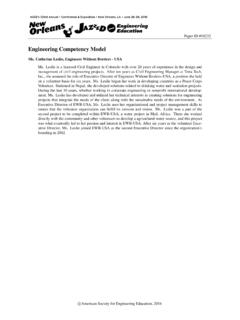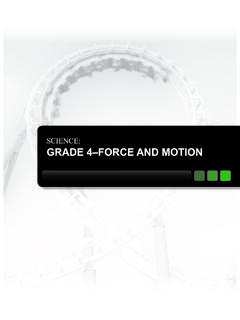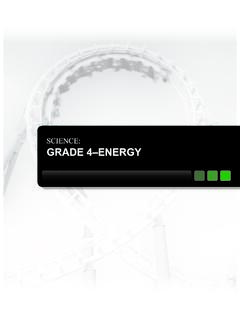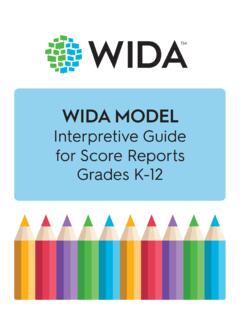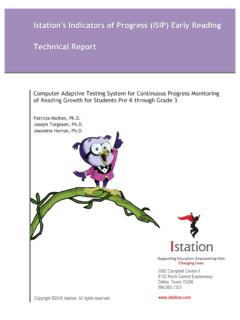Transcription of MTSS Implementation Components Updated
1 MTSS Implementation Components Ensuring common language and understanding Table of Contents Common Questions about MTSS Page # Multi-tiered systems of supports defined What are the basic Components of the problem-solving process? 2 3 How do we define Tiers 1, 2, and 3? 3 How do we differentiate Tiers 1, 2, and 3? 4 What does instruction look like in Tiers 1, 2, and 3? 4 What does assessment look like in Tiers 1, 2, & 3? 5 What is fidelity and how is it assessed? 7 How do we ensure fidelity of instructional/intervention services across the Tiers? 8 What are decision-rules and how are they connected with assessing effectiveness of instruction/intervention? 9 What are the critical elements of the district and school infrastructure that must be in place to implement and sustain MTSS?
2 9 What are the skills and activities that best define the role of coaching within a MTSS? 10 What are the sets of skills required of a principal and what activities best define the role of a principal? 11 What are the most important or highest priority elements of a program evaluation model? 11 What are some likely reasons that Implementation succeeds or fails at either the district or school levels? 12 Multi-Tiered System of Supports (MTSS) Implementation Components Common Questions 2 Multi-Tiered System of Supports (MTSS) Defined: A Multi-Tiered System of Supports (MTSS) is a term used to describe an evidence-based model of schooling that uses data-based problem-solving to integrate academic and behavioral instruction and intervention.
3 The integrated instruction and intervention is delivered to students in varying intensities (multiple tiers) based on student need. Need-driven decision-making seeks to ensure that district resources reach the appropriate students (schools) at the appropriate levels to accelerate the performance of ALL students to achieve and/or exceed proficiency. Many existing terms and initiatives share the common elements of data-based problem-solving to inform instruction and intervention ( , Positive Behavior Support [PBS], Problem Solving/Response to Intervention [RtI], Continuous Improvement Model [CIM], Lesson Study, Differentiated Accountability). Although several initiatives share this core characteristic of data-based problem-solving, the differences in the use of terms ( , the labels used to describe them), who has responsibility for implementing data-based problem-solving ( , general education, special education, student services), and the language used to describe the initiatives have often resulted in high levels of variability in the Implementation of the model at state, district and school levels.
4 These differences serve to potentially limit the impact of this model on both the integrity of Implementation and on student growth. The primary function of district leadership is to 1) ensure that a common-language, common-understanding exists around the rationale for and the purpose and expected outcomes of Implementation , 2) clearly identify who has the responsibility for what and how those individuals will be held accountable, 3) ensure that district policies are supportive of, and not barriers to, the Implementation of the model, 4) provide sufficient support (professional development, technical assistance) to ensure that the Implementation plan and timelines can be achieved and 5) identify clearly the district- and school-level leaders who will have Implementation expectations as part of their annual performance reviews.
5 Multi-Tiered System of Supports (MTSS) Implementation Components Common Questions 3 are the basic Components of the problem-solving process?The 4-step problem-solving model involves:Step 1: Define, in objective and measurable terms, the goal(s) to be attained (what is it we want students/educators/systems to know and be able to do). Step 2: Identify possible reasons why the desired goal(s) is not being attained. Step 3: Develop and implement a well-supported plan involving evidence-based strategies to attain the goal(s) (based on data that verified the reasons identified in Step 2). Step 4: Evaluate the effectiveness of the plan in relation to stated goals. Some important things to consider when using a data-based problem-solving model: problem-solving model provides the structure to identify, develop, implementand evaluate strategies to accelerate the performance of ALL use of scientifically based or evidence-based practices should occurwhenever effectiveness of the problem-solving process is based on both fidelity of theproblem-solving process itself and fidelity in the Implementation of theinstruction/intervention problem-solving process is applicable to all three tiers ofinstruction/intervention and can be used for problem-solving at the community,district, school, classroom and/or individual student How do we define Tiers 1, 2, and 3?
6 tier 1 is what ALL students get in the form of instruction (academic andbehavior/social-emotional) and student supports. tier 1 focuses on the Implementation of the district s Core Curriculum and is aligned with the learning standards. tier 1 services (time and focus) are based on the needs of the students in a particular school. Some schools require more time than other schools in particular core curriculum areas based on student demographics (readiness, language, economic factors) and student performance levels to ensure that all students reach and/or exceed state proficiency levels. tier 2 is what some students receive in addition to tier 1 instruction. The purpose of tier 2 instruction and supports is to improve student performance under tier 1 performance expectations (levels and conditions of performance).
7 Therefore, effective tier 2 services occur when at least 70% of students receiving tier 2 services (in addition to tier 1) meet or exceed grade level/subject area tier 1 proficiency levels (academic and/or behavior) established by the district. tier 2 services are more intense (more time, narrow focus of instruction/intervention) than tier 1. tier 2 services can be provided by a variety of professionals ( , general education and/or remedial teachers, behavior specialists) in any setting (general education classroom, separate settings, home). Since the number of minutes of tier 2 services is in addition to tier 1, the total amount of time a student receives tier 1 and tier 2 services is based, fundamentally, on the number of minutes all students receive tier 1 supports.
8 tier 3 is what few students receive and is the most intense service level a school can provide to a student. Typically, tier 3 services are provided to very small groups and/or individual students. The purpose of tier 3 services is to help students overcome significant Multi-Tiered System of Supports (MTSS) Implementation Components Common Questions 4 barriers to learning academic and/or behavior skills required for school success. tier 3 services require more time and a more narrow focus of instruction/intervention than tier 2 services. tier 3 services require effective levels of collaboration and coordination among the staff (general and specialized) providing services to the student. The expected outcome of tier 3 services, combined with Tiers 1 and 2, is that the student(s) will achieve tier 1 proficiency levels (academic and/or behavior) established by the district.
9 3. How do we differentiate Tiers 1, 2, and 3? The tiers are differentiated by the intensity of the services provided. Intensity is defined as the number of minutes and the focus of the instruction/intervention. An increase in the number of minutes of exposure to quality instruction/intervention and/or the narrowing of the focus of instruction would be defined as more intensive instruction. Therefore, Tiers 2 and 3 are defined within the context of tier 1. The number of minutes of instruction and the breadth of that instruction that defines tier 1 in a school will be the basis for the criteria for Tiers 2 and 3. For instance, if ALL students receive 90 minutes of reading instruction in tier 1 and that instruction includes phonemic awareness, phonics, fluency, vocabulary and comprehension, then tier 2 would be defined as additional minutes of quality instruction and/or intervention that focuses on one or more of the five areas of reading, but not all.
10 The focus would be in the area of greatest need for the student. In general, a four step process will help to define and differentiate the tiers: HOW MUCH additional time will be needed, WHAT will occur during that time, WHO is the most qualified person to deliver the What (instructional strategies) and WHERE will that additional instruction occur. tier 3 will be the most intensive instruction the building can offer. 4. What does instruction look like in Tiers 1, 2, and 3? tier 1 The delivery of instruction in tier 1 is focused on grade level/subject area/behavior standards using effective large and small group instructional strategies. Differentiated instruction occurs to a degree that is appropriate for the size and diverse learning abilities of the group and the instructional skills of the teacher.




